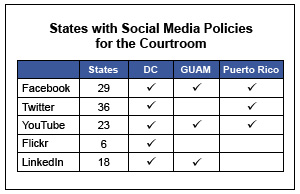Fourth Report Released on New Media’s Impact on the Judiciary

More than half of the states have policies for using Facebook and Twitter in the courtroom.

More than half of the states have policies for using Facebook and Twitter in the courtroom.
An increasing number of courts are implementing rules to control the use of new media like Facebook and Twitter in the courtroom, according to a survey released today by the Conference of Court Public Information Officers.
The 2013 CCPIO New Media Survey contains the results of a national survey of judges and court personnel conducted in June. It provides the judicial community in the United States its first year-to-year comparison spanning four years of data unraveling how social media and broader changes in the media industry are impacting state and local judges and courts.
In addition to the survey results, the report details recent developments in the past year including court cases, advisory opinions and programmatic activities by courts using social media. It is available for download at www.ccpio.org.
Since the publication of the last survey, courts have continued to experiment with social media and other new media tools to connect with the public and fulfill their obligation to be open, transparent and understandable institutions. At the same time, lawyers, judges and courts have continued to experience challenges in balancing new media use with protecting the integrity of proceedings, judicial ethics and other concerns. The 2013 surveypaints a picture of a judicial system that is optimistic about the potential new media brings while cautiously guarding against the risks.
The survey results reveal several major conclusions.
- Courts are increasingly attempting to control communication from the courtroom by developing formal social media policies.
- Most survey respondents agree that mobile devices should be prohibited from courtrooms, and a large percentage believe the general public and litigants should not be permitted to silently communicate in any way from the courtroom.
- The support for allowing the traditional news media to make video recordings and take photos in the courtroom continues to grow.
The survey was conducted by the CCPIO, an organization of more than 120 communications professionals working in state and federal courts in the United States and worldwide. Partners in the project include the National Center for State Courts in Williamsburg, Va., the nation’s leading center for research assistance to the country’s state court systems, and the E.W. Scripps School of Journalism at Ohio University.
More than 15,000 individuals in the court community were invited to participate in the electronically distributed survey. Of the total individuals who completed the survey, 31.5 percent responded they were judicial officers. Results of the 2012 survey showed 45.6 percent of respondents to be judges; 33.4 percent were judges in the 2011 survey; and 31.4 percent were judges in the 2010 survey.
“Judges and the courts increasingly recognize the impact new media is having on the judicial process inside and out of the courtroom. The research highlights the need for education, introspection and dialogue to ensure these technologies and their uses are understood,” said Thomas Hodson, of the Scripps school. “Judiciaries daily are driven to reach diverse audiences to meet the needs of the public and promote transparency. New media technologies are increasingly becoming a tool to accomplish this.”


